Abiotic and Biotic Effects on Microbial Diversity of Small Water Bodies in and around Towns
Abstract
:1. Introduction
2. Materials and Methods
2.1. Study Sites and Sample Collection
2.2. Water Quality Measurement and Biodiversity Survey
2.3. Microbe Community and Metagenomic Data
2.4. Data Analysis
3. Results
3.1. Water Quality
3.2. Fish and Wetland Plant Diversity
3.3. Microbe Community
3.4. Effects of Environmental and Biological Factors on Microbial Community Structure
3.5. Discussion
Supplementary Materials
Author Contributions
Funding
Data Availability Statement
Acknowledgments
Conflicts of Interest
References
- Blazewicz, S.J.; Barnard, R.L.; Daly, R.A.; Firestone, M.K. Evaluating rRNA as an indicator of microbial activity in environmental communities: Limitations and uses. ISME J. 2013, 7, 2061–2068. [Google Scholar] [CrossRef]
- Acharya, K.; Blackburn, A.; Mohammed, J.; Haile, A.T.; Hiruy, A.M.; Werner, D. Metagenomic water quality monitoring with a portable laboratory. Water Res. 2020, 184, 116112. [Google Scholar] [CrossRef]
- Ezzariai, A.; Hafidi, M.; Khadra, A.; Aemig, Q.; El Fels, L.; Barret, M.; Merlina, G.; Patureau, D.; Pinelli, E. Human and veterinary antibiotics during composting of sludge or manure: Global perspectives on persistence, degradation, and resistance genes. J. Hazard. Mater. 2018, 359, 465–481. [Google Scholar] [CrossRef]
- Newton, R.J.; Jones, S.E.; Eiler, A.; McMahon, K.D.; Bertilsson, S. A guide to the natural history of freshwater lake bacteria. Microbiol. Mol. Biol. Rev. 2011, 75, 14–49. [Google Scholar] [CrossRef]
- Czekalski, N.; Sigdel, R.; Birtel, J.; Matthews, B.; Bürgmann, H. Does human activity impact the natural antibiotic resistance background? Abundance of antibiotic resistance genes in 21 Swiss lakes. Environ. Int. 2015, 81, 45–55. [Google Scholar] [CrossRef] [PubMed]
- Zhao, D.; Cao, X.; Huang, R.; Zeng, J.; Shen, F.; Xu, H.; Wang, S.; He, X.; Yu, Z. The heterogeneity of composition and assembly processes of the microbial community between different nutrient loading lake zones in Taihu Lake. Appl. Microbiol. Biotechnol. 2017, 101, 5913–5923. [Google Scholar] [CrossRef] [PubMed]
- Wei, J.; Wang, M.; Chen, C.T.; Wu, H.M.; Lin, L.; Li, M. Seasonal succession of phytoplankton in two temperate artificial lakes with different water sources. Environ. Sci. Pollut. Res. 2020, 11, 42324–42334. [Google Scholar] [CrossRef]
- Bakr, N.; Abd El-kawy, O.R. Modeling the artificial lake-surface area change in arid agro-ecosystem: A case study in the newly reclaimed area, Egypt. J. Environ. Manag. 2020, 271, 15. [Google Scholar] [CrossRef]
- Holker, F.; Vanni, M.J.; Kuiper, J.J.; Meile, C.; Grossart, H.P.; Stief, P.; Adrian, R.; Lorke, A.; Dellwig, O.; Brand, A.; et al. Tube-dwelling invertebrates: Tiny ecosystem engineers have large effects in lake ecosystems. Ecol. Monogr. 2015, 85, 333–351. [Google Scholar] [CrossRef]
- Mao, R.; Zhang, X.H.; Song, C.C.; Wang, X.W.; Finnegan, P.M. Plant functional group controls litter decomposition rate and its temperature sensitivity: An incubation experiment on litters from a boreal peatland in northeast China. Sci. Total Environ. 2018, 626, 678–683. [Google Scholar] [CrossRef]
- Zhang, C.; Xu, P.; Wang, X.C.; Xu, L. Bacterial viability and diversity in a landscape lake replenished with reclaimed water: A case study in Xi’an, China. Environ. Sci. Pollut. Res. 2020, 27, 32796–32808. [Google Scholar] [CrossRef]
- Zhang, H.; Wang, Y.; Chen, S.; Zhao, Z.; Feng, J.; Zhang, Z.; Lu, K.; Jia, J. Water bacterial and fungal community compositions associated with urban lakes, Xi’an, China. Int. J. Environ. Res. Public Health 2018, 15, 469. [Google Scholar] [CrossRef]
- Zhang, X.; Xian, Y.; Wang, L.; Wang, D. Behaviour and habitat selection of Yangtze finless porpoises in Dongting Lake, China, and the adjacent waters: Impact of human activity. Pak. J. Zool. 2013, 45, 635–642. [Google Scholar]
- Newton, R.J.; Kent, A.D.; Triplett, E.W.; McMahon, K.D. Microbial community dynamics in a humic lake: Differential persistence of common freshwater phylotypes. Environ. Microbiol. 2006, 8, 956–970. [Google Scholar] [CrossRef]
- Staley, C.; Sadowsky, M.J. Application of metagenomics to assess microbial communities in water and other environmental matrices. J. Mar. Biol. Assoc. UK 2016, 96, 121–129. [Google Scholar] [CrossRef]
- Handelsman, J.; Rondon, M.R.; Brady, S.F.; Clardy, J.; Goodman, R.M. Molecular biological access to the chemistry of unknown soil microbes: A new frontier for natural products. Chem. Biol. 1998, 5, R245–R249. [Google Scholar] [CrossRef]
- Amann, R.I.; Ludwig, W.; Schleifer, K.-H. Phylogenetic identification and in situ detection of individual microbial cells without cultivation. Microbiol. Rev. 1995, 59, 143–169. [Google Scholar] [CrossRef]
- Rice, E.W.; Bridgewater, L.; Association, A.P.H. Standard Methods for the Examination of Water and Wastewater; American Public Health Association: Washington, DC, USA, 2012. [Google Scholar]
- Fang, J.; Wang, X.; Shen, Z.; Tang, Z.; He, J.; Yu, D.; Jiang, Y.; Wang, Z.; Zheng, C.; Zhu, J.; et al. Methods and protocols for plant community inventory. Biodivers. Sci. 2009, 17, 533. [Google Scholar] [CrossRef]
- Chen, Y.; Ma, X.; Du, Y.; Feng, M.; Li, M. The Chinese Aquatic Plants; Henan Science and Technology Press: Zhengzhou, China, 2012. [Google Scholar]
- Li, D.; Liu, C.-M.; Luo, R.; Sadakane, K.; Lam, T.-W. MEGAHIT: An ultra-fast single-node solution for large and complex metagenomics assembly via succinct de Bruijn graph. Bioinformatics 2015, 31, 1674–1676. [Google Scholar] [CrossRef]
- Fu, L.; Niu, B.; Zhu, Z.; Wu, S.; Li, W. CD-HIT: Accelerated for clustering the next-generation sequencing data. Bioinformatics 2012, 28, 3150–3152. [Google Scholar] [CrossRef] [PubMed]
- Langmead, B. Aligning short sequencing reads with bowtie. Curr. Protoc. Bioinform. 2010, 32, 11–17. [Google Scholar] [CrossRef] [PubMed]
- Li, H.; Handsaker, B.; Wysoker, A.; Fennell, T.; Ruan, J.; Homer, N.; Marth, G.; Abecasis, G.; Durbin, R.; Subgroup, G.P.D.P. The sequence alignment/map format and SAMtools. Bioinformatics 2009, 25, 2078–2079. [Google Scholar] [CrossRef] [PubMed]
- Buchfink, B.; Xie, C.; Huson, D.H. Fast and sensitive protein alignment using DIAMOND. Nat. Methods 2015, 12, 59–60. [Google Scholar] [CrossRef]
- Tsui, T.-H.; van Loosdrecht, M.C.M.; Dai, Y.; Tong, Y.W. Machine learning and circular bioeconomy: Building new resource efficiency from diverse waste streams. Bioresour. Technol. 2023, 369, 128445. [Google Scholar] [CrossRef] [PubMed]
- Oksanen, J.; Blanchet, F.G.; Kindt, R.; Legendre, P.; Minchin, P.R.; O’hara, R.B.; Simpson, G.L.; Solymos, P.; Stevens, M.H.H.; Wagner, H. Package ‘Vegan’: Community Ecology Package. 2017. Available online: https://github.com/vegandevs/vegan (accessed on 8 March 2022).
- Revelle, W. Package ‘Psych’, v 2.2.3. 2015. Available online: https://personality-project.org/r/psych/ (accessed on 8 March 2022).
- Kolde, R.; Kolde, M.R. Package ‘Pheatmap’. 2018. Available online: https://cran.r-project.org/web/packages/pheatmap/index.html (accessed on 8 March 2022).
- Specht, A.T.; Li, J. LEAP: Constructing gene co-expression networks for single-cell RNA-sequencing data using pseudotime ordering. Bioinformatics 2016, 33, 764–766. [Google Scholar] [CrossRef]
- Charrad, M.; Ghazzali, N.; Boiteau, V.; Niknafs, A. NbClust: An R Package for Determining the Relevant Number of Clusters in a Data Set. J. Stat. Softw. 2014, 61, 1–36. [Google Scholar] [CrossRef]
- Bartoń, K. Package “MuMIn”: Multi-Model Inference, v 1.46.0. 2022. Available online: https://cran.r-project.org/web/packages/MuMIn/index.html (accessed on 11 October 2022).
- Rosseel, Y. lavaan: An R package for structural equation modeling. J. Stat. Softw. 2012, 48, 1–36. [Google Scholar] [CrossRef]
- Ren, L.; He, D.; Xing, P.; Wang, Y.; Wu, Q. Bacterial diversity and ecological function in lake water bodies. Biodivers. Sci. 2013, 21, 421–432. [Google Scholar] [CrossRef]
- Wang, H.; Liu, X.; Wang, Y.; Zhang, S.; Zhang, G.; Han, Y.; Li, M.; Liu, L. Spatial and temporal dynamics of microbial community composition and factors influencing the surface water and sediments of urban rivers. J. Environ. Sci. 2023, 124, 187–197. [Google Scholar] [CrossRef]
- Allen, M.A.; Goh, F.; Burns, B.P.; Neilan, B.A. Bacterial, archaeal and eukaryotic diversity of smooth and pustular microbial mat communities in the hypersaline lagoon of Shark Bay. Geobiology 2009, 7, 82–96. [Google Scholar] [CrossRef]
- Herlemann, D.P.R.; Woelk, J.; Labrenz, M.; Jürgens, K. Diversity and abundance of “Pelagibacterales” (SAR11) in the Baltic Sea salinity gradient. Syst. Appl. Microbiol. 2014, 37, 601–604. [Google Scholar] [CrossRef] [PubMed]
- Neuenschwander, S.M.; Ghai, R.; Pernthaler, J.; Salcher, M.M. Microdiversification in genome-streamlined ubiquitous freshwater Actinobacteria. ISME J. 2018, 12, 185–198. [Google Scholar] [CrossRef]
- Tao, X. Analysis of Water Quality and Bacterial Diversity Based on PCR-DGGE on East Lake, Nanhu Lake, Tangxun Lake in Wuhan City. Master’s Thesis, South-Central University for Nationalities, Wuhan, China, 2016. [Google Scholar]
- Zou, S.-J.; Yin, L.-Q.; Zhao, B.-L.; Chen, P.-P.; Wei, P.-S.; Ma, X.-F. Bacterioplankton community structure characteristics in Liangzi lake and Houguan lake, Wuhan. J. Hydroecol. 2021, 42, 33–41. [Google Scholar]
- Shi, D. Microbial Community Structure of Eutrophic Urban Lake and Influence Factors. Master’s Thesis, Inner Mongolia University of Science and Technology, Baotou, China, 2021. [Google Scholar]
- Wu, X.; Xi, W.; Ye, W.; Yang, H. Bacterial community composition of a shallow hypertrophic freshwater lake in China, revealed by 16S rRNA gene sequences. FEMS Microbiol. Ecol. 2007, 61, 85–96. [Google Scholar] [CrossRef] [PubMed]
- Buosi, P.R.B.; Pauleto, G.M.; Lansac-Tôha, F.A.; Velho, L.F.M. Ciliate community associated with aquatic macrophyte roots: Effects of nutrient enrichment on the community composition and species richness. Eur. J. Protistol. 2011, 47, 86–102. [Google Scholar] [CrossRef]
- Paver, S.F.; Newton, R.J.; Coleman, M.L. Microbial communities of the Laurentian Great Lakes reflect connectivity and local biogeochemistry. Environ. Microbiol. 2020, 22, 433–446. [Google Scholar] [CrossRef] [PubMed]
- Wang, R.; Xu, S.; Jiang, C.; Zhang, Y.; Bai, N.; Zhuang, G.; Bai, Z.; Zhuang, X. Impacts of human activities on the composition and abundance of sulfate-reducing and sulfur-oxidizing microorganisms in polluted river sediments. Front. Microbiol. 2019, 10, 231. [Google Scholar] [CrossRef] [PubMed]
- You, X.; Wang, S.; Li, G.; Du, L.; Dong, X. Microplastics in the soil: A review of distribution, anthropogenic impact, and interaction with soil microorganisms based on meta-analysis. Sci. Total Environ. 2022, 832, 154975. [Google Scholar] [CrossRef]
- Dai, Y.; Yang, Y.; Wu, Z.; Feng, Q.; Xie, S.; Liu, Y. Spatiotemporal variation of planktonic and sediment bacterial assemblages in two plateau freshwater lakes at different trophic status. Appl. Microbiol. Biotechnol. 2016, 100, 4161–4175. [Google Scholar] [CrossRef] [PubMed]
- Zeng, J.; Jiao, C.; Zhao, D.; Xu, H.; Huang, R.; Cao, X.; Yu, Z.; Wu, Q.L. Patterns and assembly processes of planktonic and sedimentary bacterial community differ along a trophic gradient in freshwater lakes. Ecol. Ind. 2019, 106, 105491. [Google Scholar] [CrossRef]
- Bhatta, R.; Ghimire, P.S.; Paudyal, R.; Tripathee, L.; Gurung, S.; Regmi, D.; Joshi, R.; Sharma, C.M. Inorganic components in lake waters in the Third Pole. In Water Quality in the Third Pole: The Roles of Climate Change and Human Activities; Sharma, C.M., Kang, S., Tripathee, L., Eds.; Elsevier: Amsterdam, The Netherlands, 2020; pp. 239–259. [Google Scholar]
- Li, D.-K.; Zhuo, J.; Wang, Z. Effect of human activities and climate change on the water surface area of Hongjiannao Lake. J. Glaciol. Geocryol. 2009, 31, 1110–1115. [Google Scholar]
- Ray, A.J.; Seaborn, G.; Leffler, J.W.; Wilde, S.B.; Lawson, A.; Browdy, C.L. Characterization of microbial communities in minimal-exchange, intensive aquaculture systems and the effects of suspended solids management. Aquaculture 2010, 310, 130–138. [Google Scholar] [CrossRef]
- Simberloff, D.; Barney, J.N.; Mack, R.N.; Carlton, J.T.; Reaser, J.K.; Stewart, B.S.; Tabor, G.; Lane, E.M.; Hyatt, W.; Malcom, J.W.; et al. U.S. action lowers barriers to invasive species. Science 2020, 367, 636. [Google Scholar] [CrossRef]
- Xiong, W.; Xie, D.; Wang, Q.; Wang, H.; Wu, Z.; Sun, H.; Li, T.; Bowler, P.A. Non-native species in Poyang Lake Basin: Status, threats and management. Aquat. Invasions 2023, 18, 119–134. [Google Scholar] [CrossRef]
- Wang, H.; Xiao, K.; Wu, Z.; Chen, J.; Xiong, W.; Wang, Z.; Wang, Q.; Zhu, H.; Bowler, P.A. Delta arrowhead (Sagittaria platyphylla) in the Yangtze River: An invasive aquatic plant and the potential ecological consequences. Bioinvasions Rec. 2020, 9, 618–626. [Google Scholar] [CrossRef]
- Xiong, W.; Wang, H.; Wu, Z.; Xiao, K.; Li, T.; Bowler, P.A. Ecological and economic impacts of alien invasive yellow flag (Iris Pseudacorus l.) in China. Sustainability 2023, 15, 5905. [Google Scholar] [CrossRef]
- Pearse, W.D.; Cavender-Bares, J.; Hobbie, S.E.; Avolio, M.L.; Bettez, N.; Chowdhury, R.R.; Darling, L.E.; Groffman, P.M.; Grove, J.M.; Hall, S.J. Homogenization of plant diversity, composition, and structure in North American urban yards. Ecosphere 2018, 9, e02105. [Google Scholar] [CrossRef]
- Liu, M.; Clarke, L.J.; Baker, S.C.; Jordan, G.J.; Burridge, C.P. A practical guide to DNA metabarcoding for entomological ecologists. Ecol. Entomol. 2020, 45, 373–385. [Google Scholar] [CrossRef]
- Xiong, W.; Tao, J.; Liu, C.; Liang, Y.; Sun, H.; Chen, K.; Cheng, Y.; Chen, Y. Invasive aquatic plant (Alternanthera philoxeroides) facilitates the invasion of western Mosquitofish (Gambusia affinis) in Yangtze River, China. Aquat. Ecosyst. Health Manag. 2019, 22, 408–416. [Google Scholar] [CrossRef]
- Simberloff, D.; Holle, B.V. Positive interactions of nonindigenous species: Invasional meltdown? Biol. Invasions 1999, 1, 21–32. [Google Scholar] [CrossRef]
- Jacobs, K.; Conradie, T.; Jacobs, S. Microbial communities in the Fynbos region of South Africa: What happens during woody alien plant invasions. Diversity 2020, 12, 254. [Google Scholar] [CrossRef]
- Zedler, J.B.; Kercher, S. Causes and consequences of invasive plants in wetlands: Opportunities, opportunists, and outcomes. Crit. Rev. Plant Sci. 2004, 23, 431–452. [Google Scholar] [CrossRef]
- Shang, S.; Hu, S.; Liu, X.; Zang, Y.; Chen, J.; Gao, N.; Li, L.; Wang, J.; Liu, L.; Xu, J.; et al. Effects of Spartina alterniflora invasion on the community structure and diversity of wetland soil bacteria in the Yellow River Delta. Ecol. Evol. 2022, 12, e8905. [Google Scholar] [CrossRef]
- Rizzo, L.; Fraschetti, S.; Alifano, P.; Pizzolante, G.; Stabili, L. The alien species Caulerpa cylindracea and its associated bacteria in the Mediterranean Sea. Mar. Biol. 2016, 163, 4. [Google Scholar] [CrossRef]
- Ge, Y.; Wang, Q.; Wang, L.; Liu, W.; Liu, X.; Huang, Y.; Christie, P. Response of soil enzymes and microbial communities to root extracts of the alien Alternanthera philoxeroides. Arch. Agron. Soil Sci. 2018, 64, 708–717. [Google Scholar] [CrossRef]
- Wang, X.; Wang, X.; Wang, W.; Wang, J.; Yu, F. Effects of invasive plant diversity on soil microbial communities. Diversity 2022, 14, 992. [Google Scholar] [CrossRef]
- Mieczan, T.; Płaska, W.; Adamczuk, M.; Toporowska, M.; Bartkowska, A. Effects of the invasive fish species ameiurus nebulosus on microbial communities in peat pools. Water 2022, 14, 815. [Google Scholar] [CrossRef]
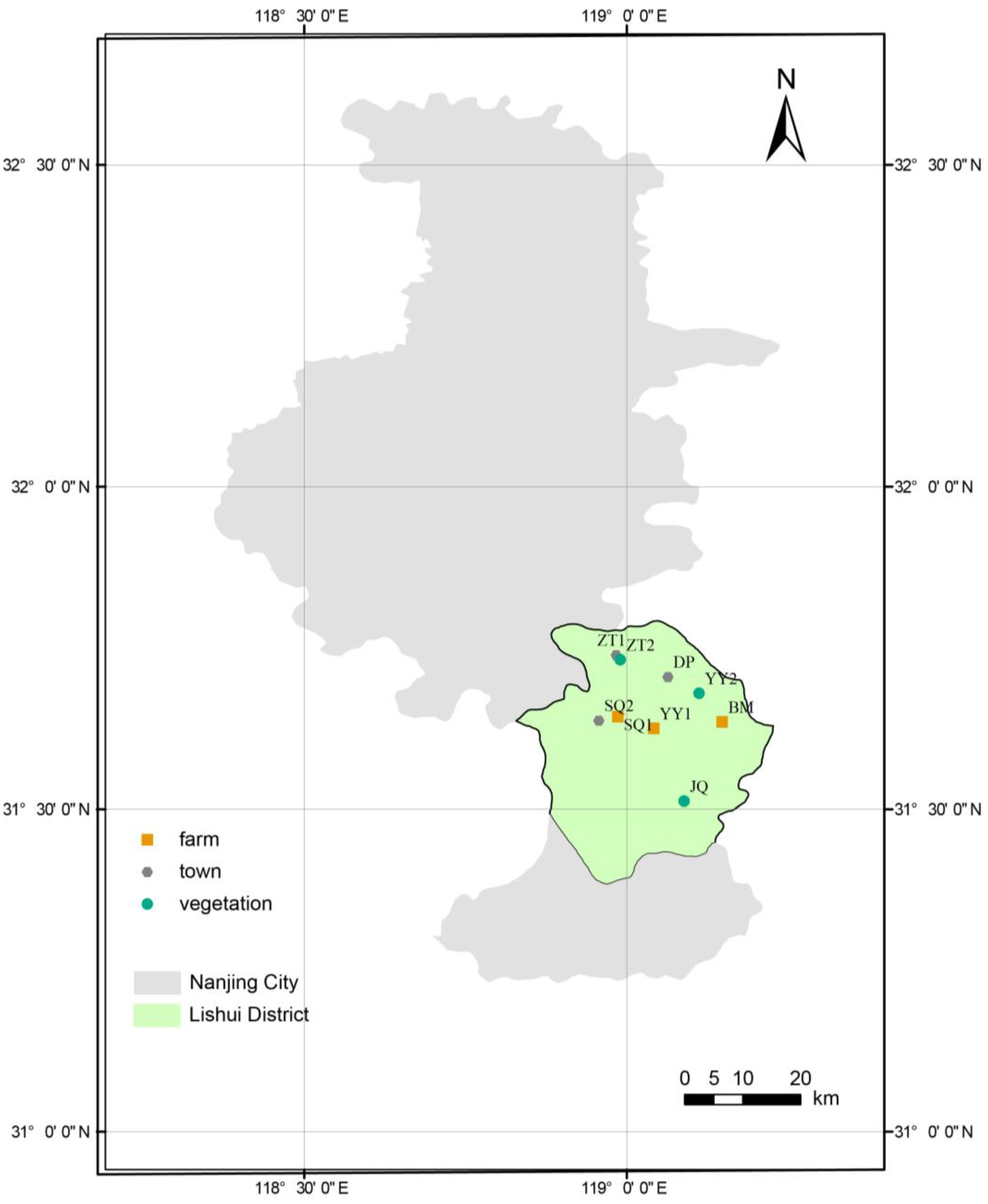
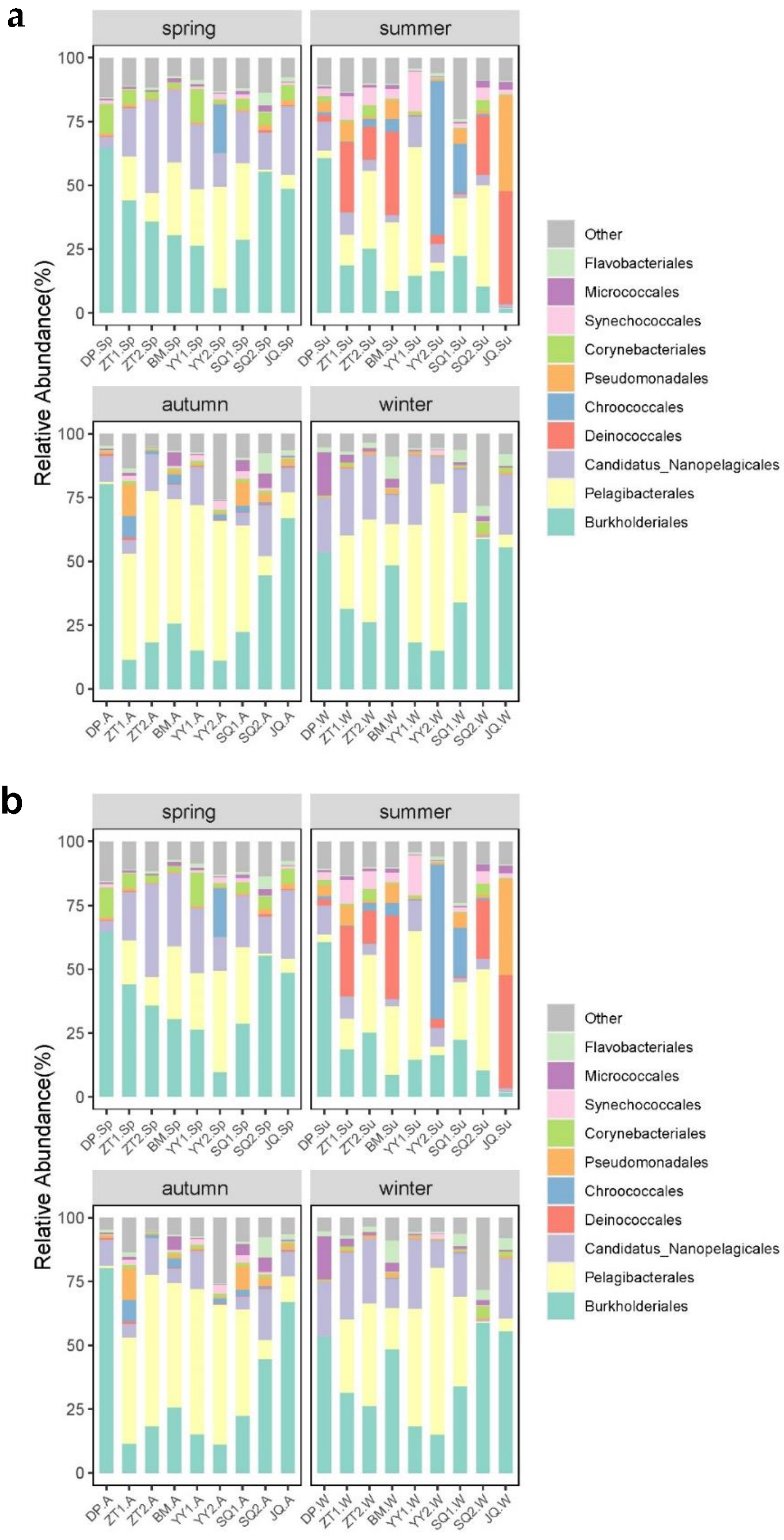

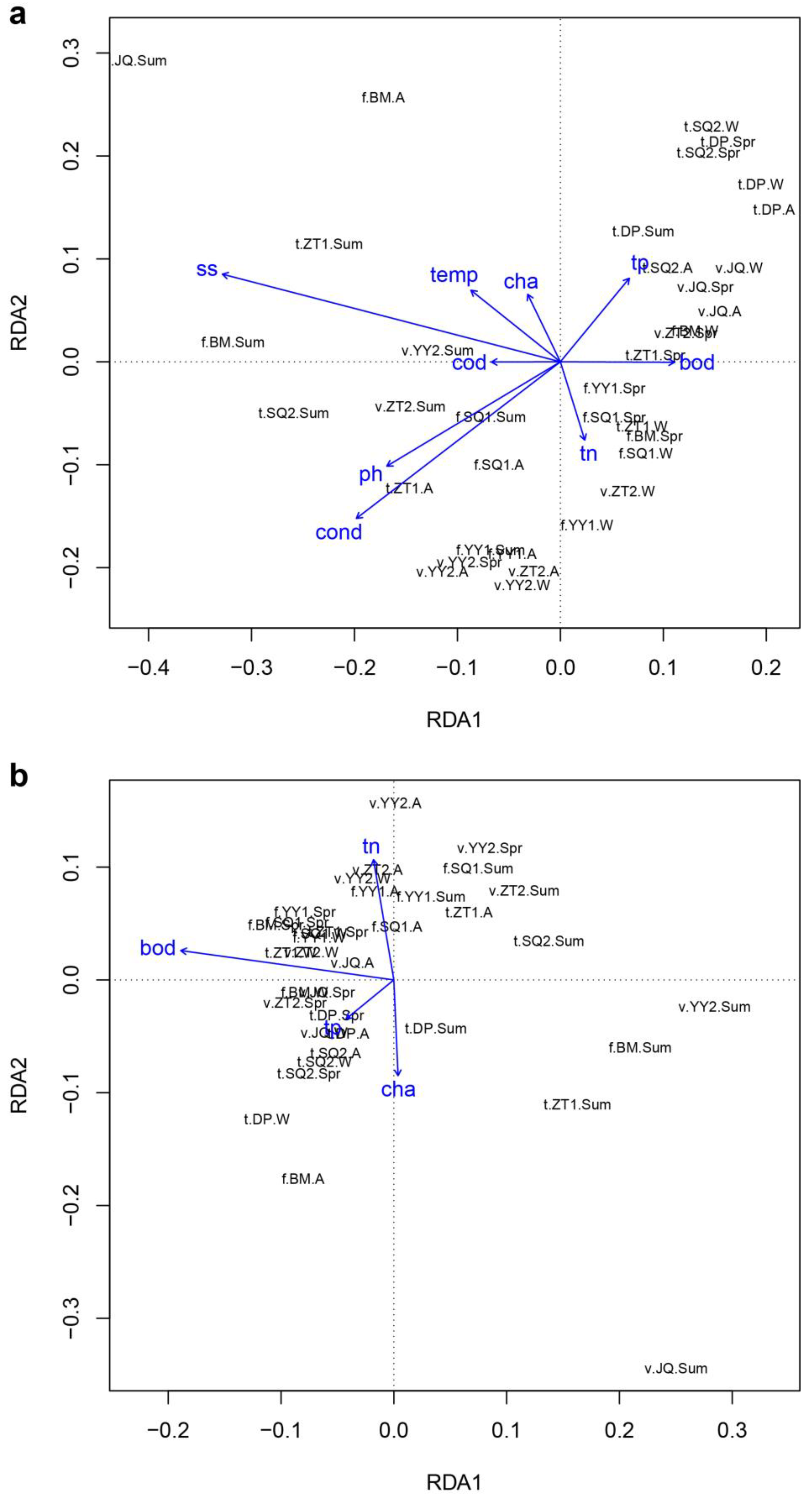
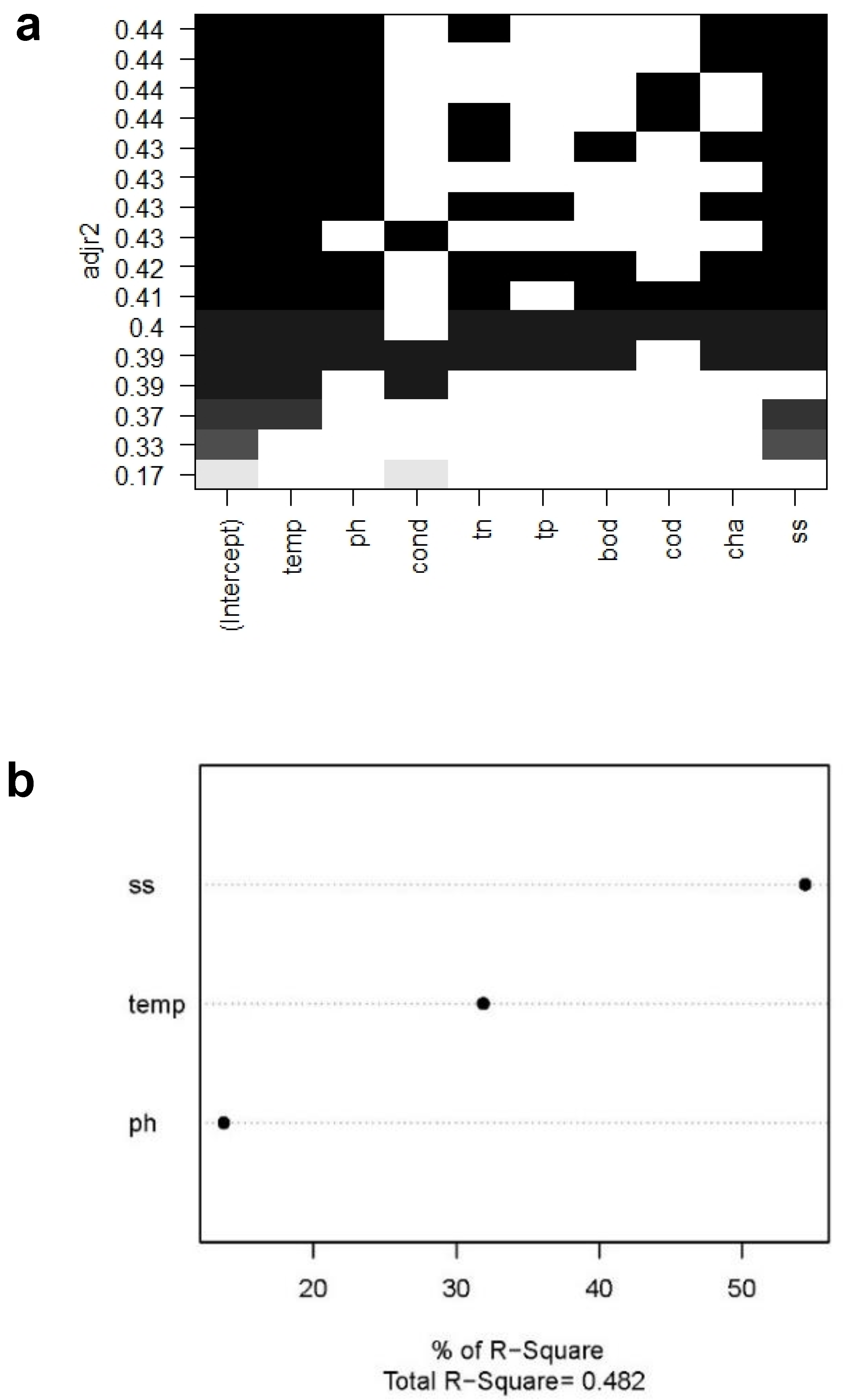
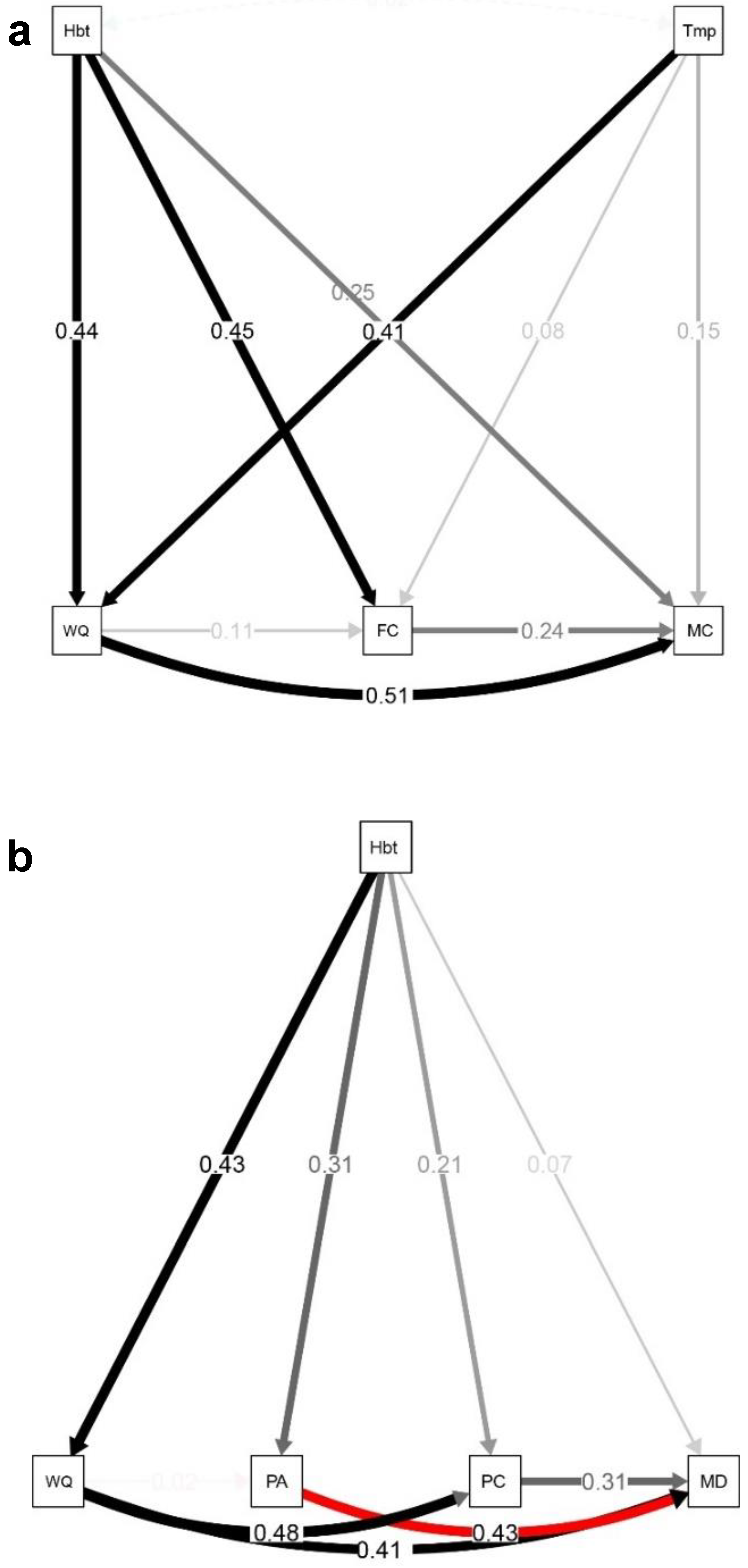
| Region | Code | Longtitude | Latitude | Habitat Type |
|---|---|---|---|---|
| Dongpin town | DP | 119.064 | 31.705 | Downtown |
| Zhetang New District | ZT1 | 118.984 | 31.739 | Downtown |
| Zhetang New District | ZT2 | 118.990 | 31.731 | Vegetation |
| Baima town | BM | 119.148 | 31.635 | Farm land |
| Yongyang town | YY1 | 119.042 | 31.625 | Farm land |
| Yongyang town | YY2 | 119.112 | 31.679 | Vegetation |
| Shiqiu town | SQ1 | 118.986 | 31.643 | Farm land |
| Shiqiu town | SQ2 | 118.957 | 31.637 | Downtown |
| Jingqiao town | JQ | 119.089 | 31.512 | Vegetation |
| DF | SS | F | R2 | P | Sig. | |
|---|---|---|---|---|---|---|
| habitat | 2 | 0.541 | 1.988 | 0.102 | 0.046 | * |
| time | 3 | 1.088 | 2.666 | 0.205 | 0.001 | *** |
| habitat:time | 6 | 0.420 | 0.514 | 0.079 | 0.988 | |
| Residuals | 24 | 3.265 | 0.614 | |||
| Total | 35 | 5.314 |
| F | R2 | P | Sig. | |||
|---|---|---|---|---|---|---|
| win | vs. | Spr | 0.830 | 0.049 | 0.412 | |
| win | vs. | Sum | 4.838 | 0.232 | 0.002 | ** |
| win | vs. | Aut | 1.432 | 0.082 | 0.194 | |
| Spr | vs. | Sum | 5.129 | 0.242 | 0.001 | *** |
| Spr | vs. | Aut | 2.214 | 0.121 | 0.063 | |
| Sum | vs. | Aut | 1.958 | 0.109 | 0.07 | |
| town | vs. | vegetation | 1.816 | 0.076 | 0.128 | |
| town | vs. | farm | 3.614 | 0.141 | 0.02 | * |
| vegetation | vs. | farm | 0.502 | 0.022 | 0.869 | |
| Model | Freedom | AICc | adj.R2 |
|---|---|---|---|
| dependent variable: MC | |||
| WQ + FC + Hbt | 6 | 84.3 | 0.533 |
| dependent variable: MD | |||
| WQ + PC + PA | 5 | 79.6 | 0.569 |
Disclaimer/Publisher’s Note: The statements, opinions and data contained in all publications are solely those of the individual author(s) and contributor(s) and not of MDPI and/or the editor(s). MDPI and/or the editor(s) disclaim responsibility for any injury to people or property resulting from any ideas, methods, instructions or products referred to in the content. |
© 2023 by the authors. Licensee MDPI, Basel, Switzerland. This article is an open access article distributed under the terms and conditions of the Creative Commons Attribution (CC BY) license (https://creativecommons.org/licenses/by/4.0/).
Share and Cite
Peng, C.; Li, P. Abiotic and Biotic Effects on Microbial Diversity of Small Water Bodies in and around Towns. Sustainability 2023, 15, 8151. https://doi.org/10.3390/su15108151
Peng C, Li P. Abiotic and Biotic Effects on Microbial Diversity of Small Water Bodies in and around Towns. Sustainability. 2023; 15(10):8151. https://doi.org/10.3390/su15108151
Chicago/Turabian StylePeng, Chao, and Pingping Li. 2023. "Abiotic and Biotic Effects on Microbial Diversity of Small Water Bodies in and around Towns" Sustainability 15, no. 10: 8151. https://doi.org/10.3390/su15108151
APA StylePeng, C., & Li, P. (2023). Abiotic and Biotic Effects on Microbial Diversity of Small Water Bodies in and around Towns. Sustainability, 15(10), 8151. https://doi.org/10.3390/su15108151





